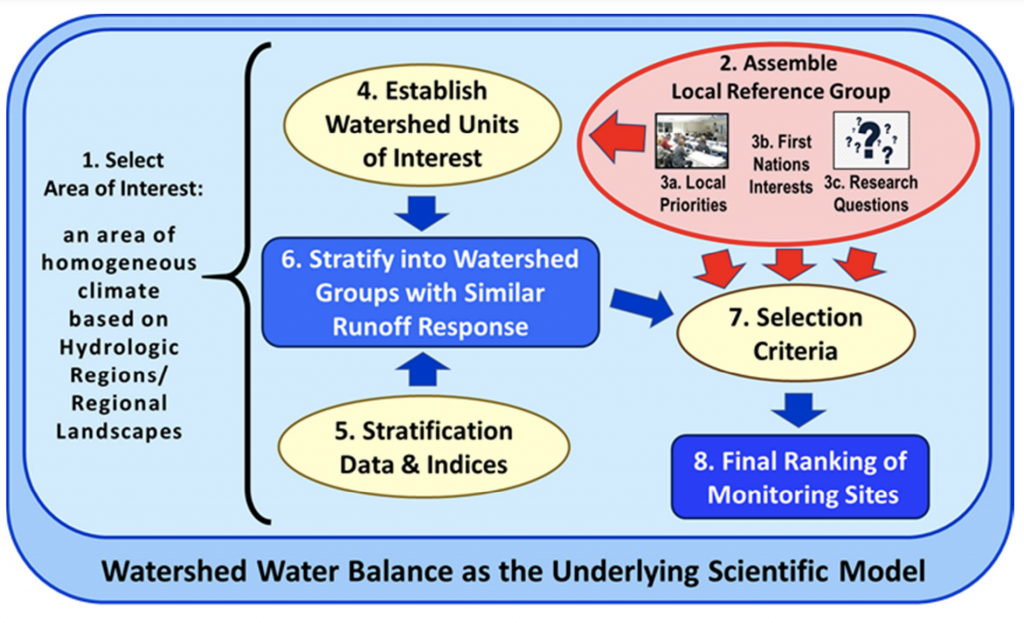Columbia Basin Water Monitoring Collaborative moving toward implementation
Climate change is rapidly impacting water resources in the Canadian Columbia Basin during a general and long-term decline in monitoring efforts. Facilitated by Living Lakes Canada, the goal of the Columbia Basin Water Monitoring Collaborative is to establish a unified monitoring program or framework in the Basin that applies a scientific water balance approach that will help to support and inform subsequent water budgets while avoiding siloed and redundant data collection.
The framework which includes a large-scale water balance approach is moving forward toward the implementation phase with a Steps for Pilot Implementation Terms of Reference document completed in April 2021. Complementary to the framework, the Columbia Basin Water Hub — an online repository for water-related data — formally launched March 2021. Included in the framework is to develop a Priority Monitoring Matrix which will use the inventory of existing monitoring to provide a preliminary water data gap analysis. The priority monitoring matrix would include local, First Nations and provincial government priority monitoring needs so that a nested approach to monitoring could build better economies of scale
Background
To lay the groundwork to design and implement a water monitoring framework, in June 2020 LLC convened a senior hydrologist workshop involving government, consultants and academia with the purpose of developing recommendations for a phased expansion of the current water (and water-related) monitoring network in the UCB. Consensus was reached that a water balance approach was needed to fill the UCB’s water data gaps. The proceedings are available here.
In May 2020, University of British Columbia published a study, Detecting the Effects of Sustained Glacier Wastage on Streamflow in Variably Glacierized Catchments, focused on the effects of glacier wastage on streamflow in the Canadian portion of the Columbia River Headwaters over a 30-year period from 1977-2017. The objective of the study was to determine the current status of streamflow trends in glacier-fed catchments. The analysis suggests that the glacier-melt contributions to August runoff in the Columbia Basin have already passed peak water and that these reductions have exacerbated a regional climate-driven trend to decreased August streamflow contributions to unglaciated areas.
As glaciers continue to diminish in size, this also means a reduction of freshwater release and subsequent decreases in water resources, requiring residents and municipalities to determine new ways of mitigating or adapting to climate change. The study outcomes reiterated rationale for the role of the Columbia Basin Water Monitoring Collaborative and the urgency around building a water balance approach to support subsequent water budgets in order to be prepared for what potentially could be an exponential drop in water supply.
Developing a Priority Monitoring Matrix
Based on the hydrology workshop’s proceedings, a “next steps” Terms of Reference (TOR) document was drafted in April 2021, intended to guide the Columbia Basin Water Monitoring Collaborative in implementing the framework for adaptive management. In the TOR, it is emphasized that the water balance approach is not enough to develop a complete Priority Monitoring Matrix for the UCB. Also required is an inventory of existing monitoring and modelling options for a preliminary gap analysis, while understanding and consolidating First Nations and local, regional and provincial government priorities for expanded monitoring..
These components are shown in the igure below where First Nations and local, regional and provincial government priorities are included along with those of watershed stewardship groups and industrial water users, which together comprise a “Local Reference Group”.

The initial implementation of this framework is on a pilot basis in select “Areas of Interest” (defined as areas of homogeneous climate based on hydrologic regions and/or regional landscapes) and allows for evaluation and iterative refinement of the process as challenges are encountered and solutions found. The long-term objective is to expand the monitoring network so it eventually covers representative locations across the UCB which will also supports more accurate modelling given accelerated climate impacts.
Once operational, additional monitoring data from the expanded network will be assessed and analyzed on an ongoing basis to identify potential adjustments in the network. Organizing the monitoring network according to Hydrological Regions provides a foundation for the overall design, rooted in contrasting regional climates. All data collected will be housed in the Columbia Basin Water Hub, which is available to community-based water monitoring groups, First Nations, municipalities, industry, and all levels of government in order to facilitate informed decision making around the Columbia Basin’s freshwater supply.
If you would like more information regarding the Columbia Basin Water Monitoring Collaborative framework, please contact LLC Executive Director Kat Hartwig at kat@livinglakescanada.ca.





